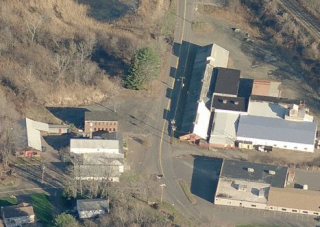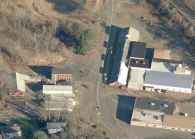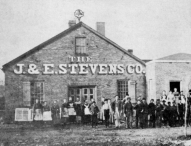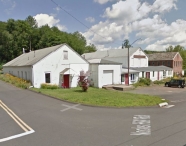Mill Record Cromwell
RETURN TO ‘FIND MILLS’Disclaimer: Content for these properties was compiled in 2014-2017 from a variety of sources and is subject to change. Updates are occasionally made under Property Information, however the Connecticut Trust for Historic Preservation (dba Preservation Connecticut) makes no representation or warranty that the information is complete or up-to-date.
- Complex Name (Common)
- J. & E. Stevens Co.
- Complex Name (Historic)
-
- J. and E. Stevens Co.
- Horton Brasses
- Address or Location
- 48 and 49 Nooks Hill Road, Cromwell
- County
- Middlesex
- Historic Designation
- Associated Mill Community

- Historic Information
Companies Associated w/Complex
- J. and E. Stevens Co. 1843-1950
- Horton Brasses Inc. 1964-2023
Use (Historic)
Largest Documented Workforce
100 (c.1870s)
Historic Narrative
John and Elisha Stevens were natives of nearby Bristol; their father was thought to be a blacksmith. The men formed the J. and E. Stevens Company in 1843, establishing a foundry to make cast iron hardware and simple toys. In 1859 the company introduced a fire cracker pistol, and began to focus primarily on the manufacture of toys. Around 1866, a new superintendent was hired: Russell Frisbee, himself a designer and pattern maker. Perhaps through Frisbee’s connections, within a couple of years the company was working with a mechanical bank designer named John Hall, of Watertown, Massachusetts., and in 1869 the firm produced the earliest known cast iron mechanical bank, patented in December 1869. Mechanical banks became a mainstay of production throughout the 19th century. Elisha Stevens apparently left the firm soon after, joining with a new partner to form Stevens and Brown c.1871; this venture began to manufacture tin toy steam engines that could actually move using steam power at a factory adjacent to the Cromwell train station. By the mid-1870s J. and E. Stevens Co. produced a wide variety of toys, including cannons and locomotives for boys, and toy stoves and kettles for girls, and claimed to be one of the largest concerns of its type in the country. Stevens employed 100 men and women and poured 1 1/2 to 3 tons of iron per day. After World War I, company production shifted back to cap pistols. Production ceased during World War II with iron being directed to wartime production. J. and E. Stevens Co. was sold in 1950. Horton Brasses Inc. took over the property in 1964 to continue and expand production of reproduction hardware, a family business started by Angeline and Frank Horton in their basement in Berlin in 1936. The company built a new foundry behind buildings from Stevens in the 1970s, and expanded the types and finishes of hardware made through the 1990s and early 2000s. Complex renovations were made in 2004-5. Manufacturing was relocated to Pennsylvania 2023. See company website: https://www.horton-brasses.com/?srsltid=AfmBOooSBzFO2v4XnO1pzdyAkwz7BuNRWww59QBlBHMJYKrThv2FZezm
- Architectural Information
Number of Existing Buildings
Four (4) blocks with modern additions.
Dates of Construction
1843, mid-19th c, c.1900
Architect
n/a
Builder
n/a
Building Type
n/a
Architectural Description
Remains of the complex occupy both sides of Nooks Hill Rd. in an otherwise non-industrial area. North of the road are three brick buildings, including the first Stevens shop, built in 1843. This 1 1/2-story, 75' x 50' building has a gable roof with cupola. Adjacent are two more brick factories, both 2 1/2-story with gable roofs, 83' x 26' and 55' x 35'. These buildings housed deburring (tumbling), grinding, polishing, painting and packing departments, as well as a small foundry where brass patterns were cast from wood prototypes. These patterns were then used to make molds in which the iron toys were cast. The extant iron foundry, 1 1/2-story and 140' x 50' with monitor roof, located across the street, was erected c.1900.(Roth)
Exterior Material(s)
n/a
Structural System(s)
n/a
Roof Form
n/a
Roof Material
n/a
Power Source
n/a
Condition
n/a
Condition Notes
n/a
- Property Information
-
Specific Location
Two legal parcels totaling 2.87 acres on either side of Nooks Hill Road east of the intersection with Shadow Lane
Adjacent To
Exterior Visible from Public Road?
Yes
Parcel ID / Assessor Record Link
Acreage
2.22; 0.65
Use (Present)
- Industrial
- Other: Sold in 2024.
- Sources
-
Form Completed By
Renée Tribert
Date
December 2016
Bibliography
- Roth, Matthew, et al, Connecticut: An Inventory of Historic Engineering and Industrial Sites (Washington DC: SIA, 1981).
- ‘Cromwell’s Iron Men Made Toys for Boys and Girls’; ConnecticutHistory.org website.
- Schreckinger, Sy. ‘The J. And E. Stevens Co. of Cromwell, Conn.’ (1988); web, Mechanical Bank Collectors of America.
- ‘George W. Brown, J. & E. Stevens Company, and Stevens & Brown’; web, The Train Collectors Association Western Division.
- Representative View(s)Click on image to view full file







